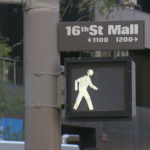Can commuter rail save our suburbs?
The mural, a train trailed by ribbons of color, is wholesome enough for a children’s book. It’s actually a paint-by-number artwork, which various residents colored in. For Arvada, Colorado, the Denver suburb that placed the mural downtown for the grand opening of its new Gold Line commuter rail station, it’s a symbol of the town’s newest chapter.
Amid recent reinvestments in Olde Town Arvada, a neighborhood of brewpubs, independent stores, and restaurants, the arrival of a rail link to Denver this past spring, after years of delay, is another catalyst in the suburb’s growth. Arvada has already seen $400 million in investment since 2006, including streetscaping and downtown redevelopment, according to Daniel Ryley, executive director of the Arvada Economic Development Association, but it’s the arrival of the rail link that has fueled even more new development and a spike in economic activity. Sales tax revenue in Olde Town grew 75 percent between 2013 and 2018 as new businesses opened in anticipation of the train’s arrival.
Within a half-mile of the station, more than 1,100 new apartments, condos, and townhomes have gone up in the last few years, according to Maureen Phair, executive director of the Arvada Urban Renewal Authority, as well as a Hilton Garden hotel. An additional 250 units will break ground next year right next to the station.
“What we don’t want to do is contribute to sprawl, traffic, and pollution,” says Phair. “The best way to avoid that is building density around these stations, and really building a place, so people can ride to work and walk to dinner.”
:no_upscale()/cdn.vox-cdn.com/uploads/chorus_asset/file/19257649/_AVD2204.jpg)
The new rail line, Ryley says, and the 20-minute ride to downtown Denver, is making it easier for businesses to retain and attract workers, building on the successful development of a walkable commercial district. Like other newly connected communities along the 11-mile, seven-station G line, such as Wheat Ridge, Arvada is becoming more walkable and urban, with denser housing. These developments are changing perceptions of what Arvada can be.
“We were fortunate to be able to host a station right in the heart of our Olde Town community,” Ryley says. “It’s a real unique asset.”
Growing cities see rail as a ticket to world-class status
The new G Line, part of a number of recent and planned expansions of Denver’s Regional Transportation District, shows how growing metros in the West and the Sun Belt are betting big on improved suburban transit, including expanding light-rail lines and building new commuter rail services. It’s a trend that’s taken off over the last 15 years, according to Paul Lewis, vice president of policy and finance at Eno Center for Transportation. The American Public Transportation Association says commuter rail use has been steadily increasing since the late ‘90s, and grew 9.2 percent, or by more than 42 million additional trips, in the last decade alone.
Mimicking the commuter rail lines that stretch out from Northeast cities like New York, these new suburban transit options tend to be renovations of underutilized or unused freight lines. Similar plans propose or plan to open new lines in the next five-plus years in Seattle, Houston, Massachusetts, Dallas, and Miami.
“As cities grow and want to be world-class and compete on a global scale, they need to show a map with transit and rail lines,” says Lewis.
The price is certainly right: By repurposing existing lines, transit agencies forgo costly land acquisition and rail construction costs and focus on stations, parking lots, and passenger cars. Around these stations, transit-oriented development has spread and walkable and profitable downtown suburban developments have increased.
In the northern suburbs of Dallas, where Dallas-Area Rapid Transit (DART) plans to open the 26-mile Silver Line extension in 2022 to knit together growing cities such as Grapevine, Carrollton, Richardson, and Plano, roughly $1 billion in commercial space, multifamily, and retail is taking shape in and around planned stations, according to David Leininger, a former DART executive helping Richardson and Addison on transit-oriented developments.
This new generation of commuter rail is far from perfect. Because the routes are built on existing freight lines that run like spokes out of downtowns, they may not connect the densest areas of housing, jobs, and entertainment in each region. This problem hinders Denver’s growing rail system, which doesn’t terminate in the densest part of the city. And in many cases, bus rapid transit could do a better job of connecting the city to the car-dependent suburbs by utilizing existing high-use roadways and traveling on a more strategic, flexible route at a much lower cost.
:no_upscale()/cdn.vox-cdn.com/uploads/chorus_asset/file/19257651/_AVD2395.jpg)
These new lines also run on hours designed to appeal to more affluent downtown office workers—sometimes called “choice riders,” as opposed to “dependent riders”—when the majority of transit users don’t actually work a 9-to-5 day. And while local transit measures have been mostly successful at the ballot box over the last few years, high-profile defeats, especially in North Carolina, Nashville, and the Atlanta suburbs, where local voters rejected big-ticket rail expansions, show that not everyone is convinced commuter rail is a bargain for taxpayers.
But in cities where funding has come through, many of these new transit options have spurred building booms along transit corridors, and they’ve shown that a more sustainable, car-free commute is possible, at least for a small group of riders.
How rail lines link the suburbs to jobs and growth
Ryley says that just the announcement of the new G Line station in Arvada ramped up development. A new wave of construction broke ground in 2011, way before the G Line was supposed to be finished (delays pushed the projected 2016 opening date back to this May). When it was clear the line had enough support, funding, and momentum to be completed, a wave of multifamily projects began breaking ground, such as the 26-acre Water Tower Village, and new independent businesses opened their doors in Olde Town, including the Bluegrass Lounge, Hunter Bay coffee lounge, Homegrown Tap & Dough, and Steubens Restaurant.
Ryley says that by linking the city to customers and workers, the G Line is helping business boom. Other developing or expanding rail systems have seen, or are betting on, similar growth. South Florida’s Tri-Rail, which has served the Miami area since opening in 1989, has seen 6 percent passenger growth over the last five years to 16,000 riders daily, and a proposed 9-mile Downtown Miami Link would let system riders take the train all the way to the forthcoming MiamiCentral Station.
Texas cities also have high hopes for rail-led development. Houston will ask voters to approve a $7.5 billion expansion of transit, including more light rail and a rail link to Hobby Airport. Dallas’s Silver Line, a $1.2 billion investment in a radial line linking northern suburbs and other existing rail services, aims to better intertwine a crescent-shaped swath of emerging cities and job centers from Plano to the stockyards near downtown Fort Worth.
According to Leininger, the former DART exec, the suburbs see commuter rail as a significant infrastructure boost, and have responded with investments and policies stimulating new development. Grapevine is modeling its station on Denver’s Union Station (“You walk off the platform and feel like you’re walking into a development,” says Leininger), Richardson established a tax-increment finance district to raise $25 million to assist with construction, Addison bought up 12 acres near the station that it’s selling to a master developer, and the University of Texas-Dallas, which will get its own station, has pushed development on the north side of campus adjacent to the station.
“Suburbs have actually embraced transit-oriented development more enthusiastically than the city of Dallas,” says Leininger. “That urban-suburban combination is a big selling point these days.”
When the Silver Line finally opens in 2022, there will be developments already open for business near every station. And the transit nodes created at stations where the Silver Line hooks up with the Green and Red lines will really create dense areas of development. Leininger, who also works with the Urban Land Institute, contributed to a study of all 100 rail stations in the Dallas-Fort Worth Metroplex, including DART and other systems, and found that developments adjacent to a rail station always commanded a premium compared to the same project elsewhere in the region.
Limits to the commuter rail rebirth
Dallas-area developers, sadly, seem to be an exception to the rule. The DART Silver Line will start operations just as community efforts to encourage dense development near stations, through investments and land use rules, begin to bear fruit. But most U.S. commuter rail still fails in this regard, surrounding stations with parking lots instead of shops, jobs, and homes.
“The big problem we see with lots of these new train systems isn’t the distances they travel, it’s the land use,” says Eno’s Lewis. “Surrounding areas aren’t incentivized for dense land use, only riders willing to park and ride downtown.”
:no_upscale()/cdn.vox-cdn.com/uploads/chorus_asset/file/19257654/20190605_arvada_spring_029.jpg)
The other big downside is transit frequency. U.S. systems run paltry service past peak hours, making it hard for these lines to function like true everyday transit. By comparison, mature European systems, like the RER commuter rail servicing areas ringing Paris, run multiple times an hour and act as extended light-rail or subway lines.
Still, while transit ridership has seen troubling declines across the board, Lewis and others do see commuter rail and efforts to increase service becoming more popular. Even the defeat in Atlanta’s Gwinnett County was the closest the area has ever come to transit expansion.
Lewis believes change requires investment and consistency. Cities and states that propose and pass funding for these systems, invest in land-use plans that develop areas around stations, and create service schedules that serve all users can create a virtuous cycle: better transit service, more business in tax-collecting transit-adjacent developments, and more money to support transit expansion.
Arvada has seen a boom with the G Line’s arrival, and wants to make sure it stays. Ryley says the city will soon embark on a comprehensive rewrite of zoning and land-use policies to help develop more density, as well as draw more foot traffic and more diverse businesses. Opening the rail line is just the first step.
Phair says that the city is already looking at a second hotel and adding more commercial real estate around the new station. The parking garage near the station is full every day, and many residents of the new apartments nearby have been able to give up their cars. But development in the Denver area is “such a four-letter word.” There’s lingering public sentiment against change, new development, and rising rents.
“This is great planning, and smart development, and we need to find out how to communicate the value of these developments,” she says. “When we don’t take advantage of the proximity to transit, that’s not good for the future. It’s a shame when development occurs and doesn’t take advantage of a transit link.”
![DRMAClogo[1] DRMAC](https://drmac-co.org/wp-content/uploads/2019/12/DRMAC20logo1.jpg)




Leave a Reply
Want to join the discussion?Feel free to contribute!